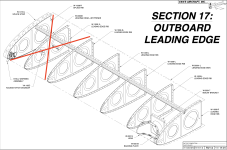I'm a new builder and I'm currently working on the leading edges for my RV-14A wings. I'm also installing the Sky Designs ER fuel tanks. One of the modifications you have to make with the ER fuel tanks is to shorten the leading edge wing skins by two rib bays (and extend the fuel tanks by the same two rib bays). The part of the leading edge skin that is removed is where the factory stall warning assembly and access hatch plate goes (see diagram below).
Since I would need to cut new holes in the shortened skins to add the stall warning and access panel further outboard on the wings it made me question whether I should install the factory stall warning at all. It appears many people don't install the stall warning because of the AOA built into the pitot. My dilemma is I've only flown Cessnas and only have experience with "old school" stall warning systems.
First question - Is the access hatch shown below ONLY used to get access to the stall warning assembly for removal/maintenace?
Second question - I'm not planning on using a dash mounted AOA display. I'm used to the audible stall warning sound in a Cessna. Does the Garmin GAP26 pitot and G3X system generate an audible stall warning like a Cessna?
If the answer to both questions is yes, I don't think I'll install the stall warning assembly or the access hatch.
Thoughts???

Since I would need to cut new holes in the shortened skins to add the stall warning and access panel further outboard on the wings it made me question whether I should install the factory stall warning at all. It appears many people don't install the stall warning because of the AOA built into the pitot. My dilemma is I've only flown Cessnas and only have experience with "old school" stall warning systems.
First question - Is the access hatch shown below ONLY used to get access to the stall warning assembly for removal/maintenace?
Second question - I'm not planning on using a dash mounted AOA display. I'm used to the audible stall warning sound in a Cessna. Does the Garmin GAP26 pitot and G3X system generate an audible stall warning like a Cessna?
If the answer to both questions is yes, I don't think I'll install the stall warning assembly or the access hatch.
Thoughts???





